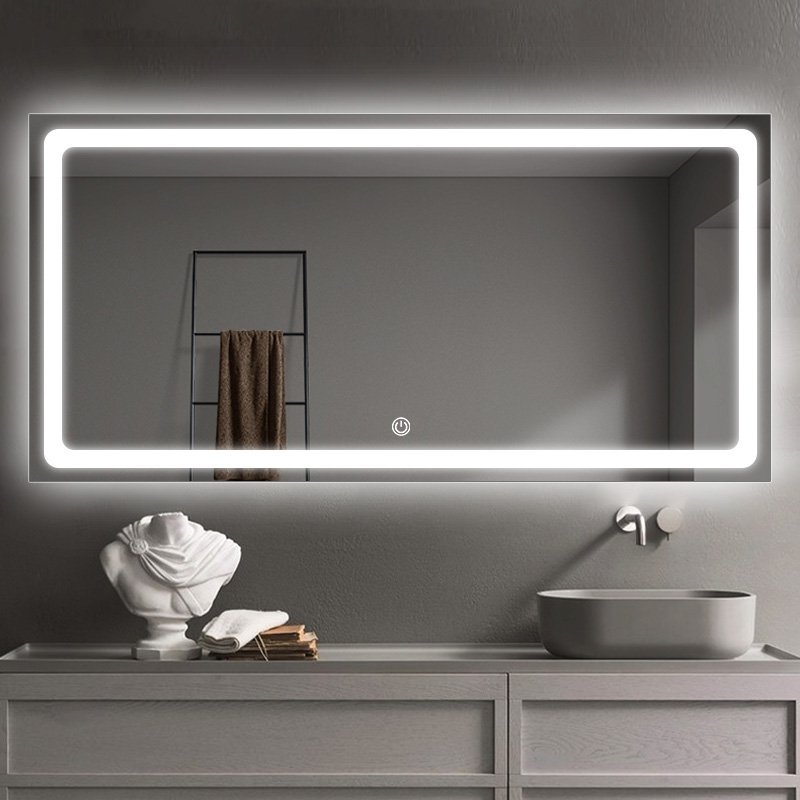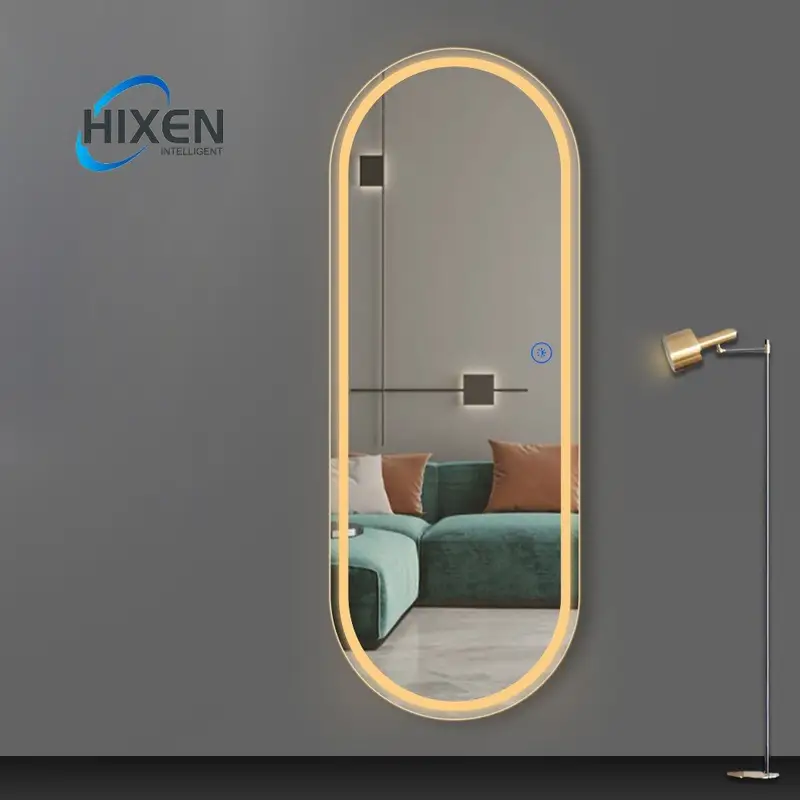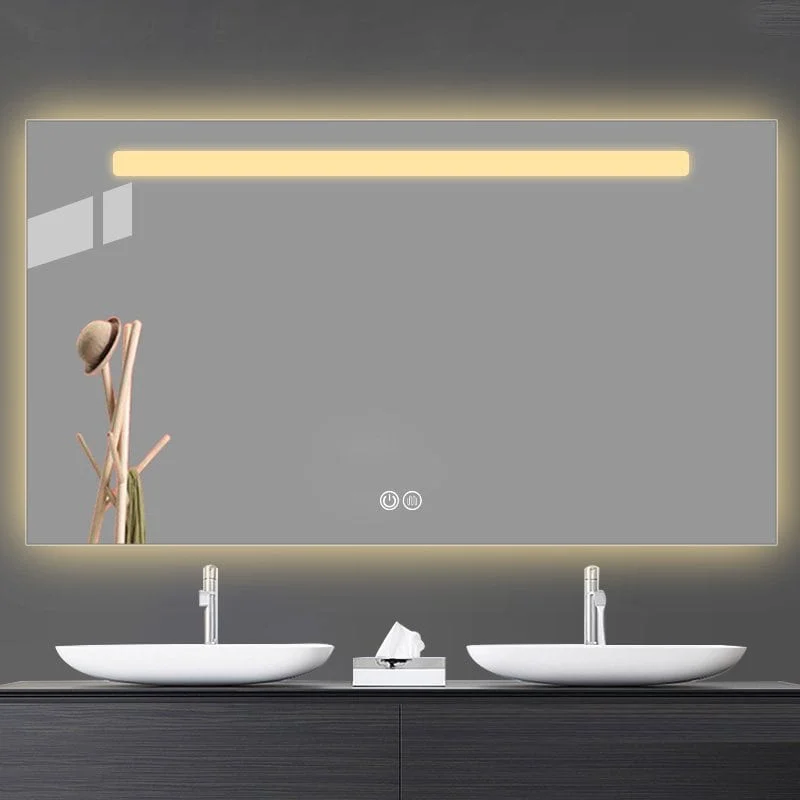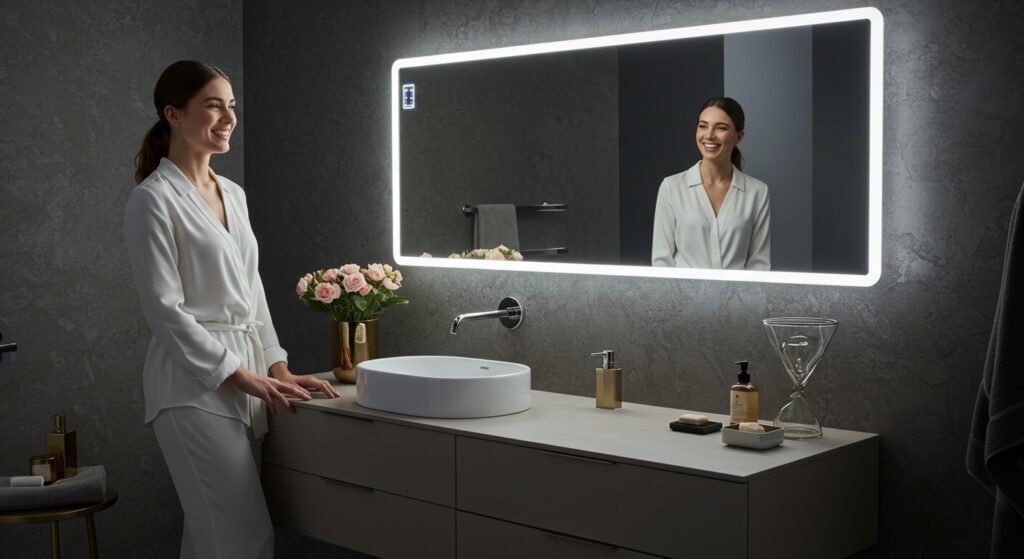|
Getting your Trinity Audio player ready...
|
How to clean a mirror with water?Cleaning mirrors with water often leaves frustrating streaks and water spots. This common household mistake can damage your mirror’s surface and reduce clarity. Here’s the proper way to achieve spotless results.
To clean a mirror with water properly: use distilled water, spray lightly on the surface, wipe in circular motions with a microfiber cloth, then dry immediately with a clean, dry cloth to prevent water spots and streaks.
Let’s explore comprehensive techniques for cleaning different types of mirrors effectively.

Is It Okay to Clean a Mirror with Water?
Many homeowners question whether water alone is sufficient for cleaning their bathroom mirrors and vanity mirrors effectively.
Yes, it’s okay to clean mirrors with water, but distilled water works best. Tap water can leave mineral deposits on glass mirrors, bathroom light mirrors, and lighted vanity mirrors, reducing their clarity and lifespan.
Water is generally safe for most mirror types, including modern lighted mirrors for bathrooms, led bathroom mirrors, and traditional glass mirrors. However, the quality of water matters significantly. Distilled water eliminates mineral content that causes white spots and streaking.
When it comes to more expensive lighted makeup mirrors or vanity mirrors with led lights, you want to use distilled water to clean these because not only do you protect the reflective surface, but you also protect the lighting components around the edge. Because what happens is if you just use regular tap water to clean this type of mirror, over time, you can get mineral deposit buildup.
What Is the Best Way to Clean a Mirror?
The optimal mirror cleaning method depends on your mirror type, from simple bathroom vanity mirrors to sophisticated led light mirror vanity setups.
The best mirror cleaning method combines distilled water with white vinegar (1:1 ratio), microfiber cloths, and proper technique. This works for all mirror types including rectangular bathroom mirrors, light up vanity mirrors, and wall mirrors with lights.
There are several steps to professional cleaning whether you’re taking care of small bathroom mirrors or huge modern lighted bathroom mirrors. First, dry dust using a clean microfiber cloth to remove surface particles. If it’s a lighted vanity mirror for bathroom usage, make sure the power is off.
Don’t oversaturate the mirror because you don’t want any of your cleaning solution to get into any electrical components around the edges of the mirror. You would work from the top down, eoverlapping your strokes slightly, then immediately dry the mirror with a separate clean cloth. This method helps prevent moisture from getting into the electronic components of led bathroom mirrors or bathroom vanity lights.

How to Clean a Mirror Without Streaks?
Streak-free cleaning requires specific techniques that work consistently across different mirror styles and bathroom lighting conditions.
Prevent streaks by using distilled water, working in small sections, avoiding circular motions, wiping vertically then horizontally, and drying immediately with a lint-free cloth. This technique works for all mirror types.
The key to avoiding streaks on lighted bathroom mirrors and led mirrors is understanding how light exaggerates any imperfections. Use the squeegee method with larger surfaces like modern lighted mirrors for bathrooms. You start at the top in one corner and pull straight down in slightly overlapping strokes.
For smaller lighted vanity mirrors, you can use the newspaper method. After you finish cleaning with the microfiber cloth, use crumpled newspaper to do your final polishing. One thing to note is the temperature. You don’t want to clean the mirrors when they’re warm from the bathroom vanity lights or when the temperature in the room is fluctuating. This can cause rapid evaporation and streaking. You want to keep the moisture consistent throughout your cleaning process.
How to Clean a Mirror That Is Hazy?
Hazy mirrors, particularly common in bathroom environments with high humidity, require specific restoration techniques to regain crystal clarity.
Clean hazy mirrors using a stronger vinegar solution (2:1 vinegar to water), let it sit for 5 minutes, then scrub gently with microfiber cloth in circular motions before final cleaning with distilled water.
What causes haze on mirrors? Normally, haze on mirrors is caused by soap residue, hard water buildup, or damage from humidity, especially around your vanity lights for bathroom vanity mirrors. If you end up with severe haze on led bathroom mirrors or backlit mirrors, you can create a paste using baking soda and water. Apply it gently to the area, then rinse thoroughly.
Remember to be very careful if your lighted makeup mirror includes electrical components. You want to be sure everything is secured and insulated from moisture. If the mirror is older or rectangular, the haziness may be due to age or damage to the silvering. In this case, you might need to get the mirror professionally re-silvered. To prevent future issues, improve bathroom ventilation in the area of your vanity mirror with led lights.

How to Clean a Mirror with Vinegar?
White vinegar provides an effective, natural cleaning solution for most mirror types while being safe for sensitive electrical components.
Mix equal parts white vinegar and distilled water in a spray bottle. Spray lightly on mirror surface, wipe with microfiber cloth, then dry immediately. This solution effectively removes buildup without damaging mirror coatings or electrical components.
The acetic acid in vinegar is excellent for dissolving mineral deposits and soap scum that often form on bathroom mirrors and around vanity lights. This is another reason that vinegar is good for cleaning led mirrors and lighted vanity mirrors for bathroom use. It dissolves the buildup that diffuses the light.
The acetic acid in vinegar is exceptional for dissolving mineral deposits and soap scum that often form on bathroom mirrors and around vanity lights. This is once again why vinegar is good for cleaning led mirrors and lighted vanity mirrors for bathroom use. It dissolves the build-up that diffuses the light.
How to Clean Mirrors Naturally?
Natural cleaning methods offer safe alternatives for maintaining various mirror types without harsh chemicals that might damage delicate surfaces.
Natural mirror cleaning uses lemon juice, baking soda, or cornstarch mixed with water. These ingredients effectively clean glass mirrors, bathroom light mirrors, and lighted vanity mirrors without chemical residue or electrical damage risks.
Lemon juice mixed with warm water (a 1:4 ratio) works wonders on small bathroom mirrors and light up vanity mirrors. It’s acidic and is natural, which helps. Water mixed with cornstarch makes a great polish. And when used as a polishing agent, cornstarch is particularly helpful in getting a streak-free result on backlit mirrors because they will spotlight any imperfection.
Use baking soda paste to tackle stubborn spots on modern lighted mirrors for bathrooms. You don’t want to use anything abrasive that could scratch the delicate surface. These natural cleaning methods are particularly useful for keeping lighted makeup mirrors in bedrooms clean without introducing chemical fumes. Club soda is also an effective natural cleaner for led vanity mirrors. It cleans without leaving any residue.

Mirror Cleaning Techniques Comparison
| Cleaning Method | Best For | Pros | Cons | Suitable Mirror Types |
|---|---|---|---|---|
| Distilled Water Only | Light daily cleaning | No chemical residue, safe for all mirrors | Limited cleaning power | All types including led mirrors, backlit mirrors |
| Vinegar Solution | Regular maintenance | Removes mineral deposits, natural | Strong odor, may damage some finishes | Glass mirrors, bathroom vanity mirrors, lighted vanity mirrors |
| Commercial Cleaners | Heavy-duty cleaning | Strong cleaning power, convenient | Chemical residue, expensive | Traditional mirrors, avoid on sensitive led light mirror vanity |
| Natural Methods | Eco-friendly cleaning | Safe, non-toxic | Time-consuming, variable results | All mirror types, especially lighted makeup mirrors |
How to Clean Mirror Stains at Home?
Stubborn stains on mirrors require targeted approaches depending on the stain type and mirror style, from basic bathroom vanity mirrors to sophisticated lighting systems.
Remove mirror stains using appropriate solutions: rubbing alcohol for adhesive residue, vinegar paste for hard water spots, and gentle abrasives for paint or permanent marks. Always test on inconspicuous areas first, especially for specialty mirrors.
Different stains will require specific treatments based on each type of mirror. For example, toothpaste or hairspray marks on a mirror light up vanity mirror might respond well to rubbing alcohol. If you are getting water spots on a rectangular mirror over your bathroom sink, which is common if you have glass shower doors in your bathroom, you can make a paste with vinegar and baking soda, apply it to the mirror, let it sit for 10 minutes, and then gently scrub.
If you have paint splatters on a mirror in your room, you can soften them with warm soapy water. Then use a plastic scraper to be gentle in getting it off. On valuable pieces like antique lighted makeup mirrors and light up vanity mirrors in your bedroom or modern bathroom mirrors with integrated technology, you need to be careful. It may be better to have a professional take care of the stain than to risk damaging it with aggressive home remedies. Just be safe and make sure that if you’re treating the electrical area on a lighted vanity mirror, you unplug it first.

Why Does Plain Water Leave Streaks on Mirrors?
Understanding why water creates streaks helps choose better cleaning methods for different mirror types and water quality conditions.
Plain tap water leaves streaks because dissolved minerals like calcium and magnesium remain on the mirror surface after water evaporates, creating visible white spots and cloudy residue that affects reflection quality.
Water quality varies significantly by region, which will impact how water works with mirrors. If you live in an area where you have hard water (which is a challenge when it comes to maintaining led bathroom mirrors and modern lighted mirrors for bathrooms), then you have to deal with water spots that show up against the background of those lights.
The minerals in tap water – primarily calcium carbonate and magnesium and sometimes iron – are left behind when the water evaporates. This film of minerals is especially problematic when it comes to the light up vanity mirrors and wall mirrors with lights we talked about earlier. Even microscopic bits of the minerals in hard water will scatter light and reduce clarity on these mirrors. So, understand your local water hardness and whether or not you will need to use distilled water for maintaining your specific mirror types, from simple small bathroom mirrors up to lighted vanity mirrors for bathroom use.
How to Prevent Water Spots When Cleaning Mirrors?
Prevention strategies for water spots ensure long-term clarity for all mirror types while protecting electrical components in modern lighting systems.
Prevent water spots by working in small sections, using distilled water, drying immediately after cleaning, working during cooler temperatures, and maintaining proper bathroom ventilation around mirror installations.
Prevention comes into play by understanding what you have going on in terms of your environment with these different types of mirrors. If you have bathroom vanity lights or vanity mirrors with led lights, make sure you have good ventilation. This way, you won’t have a problem with humidity harming your mirrors and causing those water spots to form. If you do need to clean your mirrors, do it when the surface is cool. Don’t clean a mirror as soon as you get out of a hot shower and it’s been warmed up and steamed because they’re going to dry off quickly, and you’ll have spots.
Refer to our technique called the two-cloth method. You have one cloth that’s slightly damp with distilled water, and that’s the one you use for the cleaning, and you have a completely dry cloth that’s used for the immediate drying. This two-cloth technique when combined with using distilled water is especially important when it comes to maintaining your led vanity mirrors and your backlit mirrors where those water spots are going to show up and be so visible. If you happen to have a real problem in your bathroom with water spots on your modern bathroom mirrors in your house, you might want to consider installing an exhausting fan or some type of exhaust fan to pull that moisture out of the air and help you control it.

Cleaning Frequency and Maintenance Schedule
| Mirror Type | Daily Cleaning | Weekly Deep Clean | Monthly Maintenance | Special Considerations |
|---|---|---|---|---|
| Basic Bathroom Mirror | Quick wipe if needed | Vinegar solution clean | Check for damage, deep clean | Simple maintenance routine |
| LED Bathroom Mirror | Dust removal | Full cleaning with power off | Electrical connection check | Safety first, avoid moisture near electronics |
| Lighted Vanity Mirror | Spot cleaning | Complete surface and light cleaning | Bulb replacement, wiring inspection | Professional service for electrical issues |
| Backlit Mirror | Daily dusting | Careful cleaning avoiding edges | Seal inspection, light function test | Prevent moisture penetration |
What Should You Know When Cleaning LED Mirrors with Water?
Led mirrors require special considerations during water cleaning to protect both reflective surfaces and integrated electrical components safely.
When cleaning led mirrors with water, always disconnect power first, avoid spraying directly onto electrical components, use minimal moisture, and ensure complete drying before reconnecting power to prevent electrical damage.
Safety protocols for cleaning lighted vanity mirrors and led light mirror vanity systems require understanding electrical risks. Water and electricity create dangerous combinations, so proper preparation is essential. Before cleaning any lighted makeup mirror or vanity mirror with led lights, locate and switch off the electrical source. For hardwired modern lighted mirrors for bathrooms, this might require switching off circuit breakers.
Use spray bottles sparingly around electrical connections, applying cleaning solutions to cloths instead of directly spraying surfaces. Pay special attention to areas around bathroom vanity lights and connection points where moisture could penetrate. After cleaning, allow complete air drying before restoring power. For expensive installations like wall mirrors with lights or integrated bathroom vanity mirrors, consider professional cleaning services to maintain warranties and ensure safety compliance.

Conclusion
Proper mirror cleaning with water requires understanding your specific mirror type and water quality. Whether maintaining simple glass mirrors or sophisticated led bathroom mirrors, success depends on using appropriate techniques, quality water, and safety precautions for electrical components.
- To learn how to pick the right bathroom mirror click here.
- To learn how to install a mirror choose here.
- To learn how to pick the right size mirror click here.
- To learn how mirrors are made click here.
- Click here and you will learn why we look better in mirrors.
- Click here you will learn about the TOP 10 led mirror manufacturers for 2024.
- Click here to find out Why doesn’t my vanity mirror light come on?
- Find out How Tall Should Bathroom Mirror Be? Click Here
- Click here if you don’t know how to clean your mirror
- To find out how to fix Touch Sensor Mirror Not Working click here
- Find out 10 Common LED Bathroom Mirror Problems Click Here

























